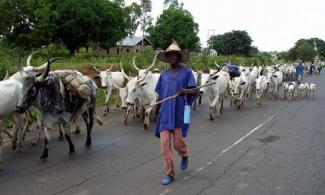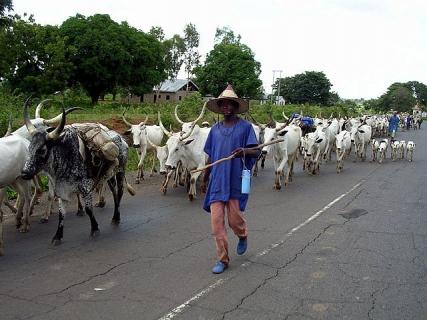
Not all pastoralists and cattle rearers in and around the North are Fulani. The Kanembu, Kwoya, Manga and Shuwa Arabs, are minor tribes in the cattle industry. The Fulani tribe is a mass of 20 to 25 million people.
The spate of killings by Fulani herdsmen has gone up another notch during the turn of the year, this has raised so many questions on the motive behind the killings and how it can be managed.
Inspector General of Police—Ibrahim Idris, has attributed the killings to the anti-open grazing law in Benue and Taraba. He expressed this view while responding to summons from the Senate Joint Committee on Police and National Intelligence on the 2nd of February.
However, in Plateau state where there is no law against open grazing, four persons were killed, ten injured and homes burnt down in Josh Village, Daffo Chiefdom, Bokkos Local Government on 26th January. The village chief said the attack could be in connection with a grazing space dispute between the villagers and the nomads. While normalcy might have returned to the community, a permanent solution to the wanton killings remains elusive.

In a related development, these herdsmen laid siege on another community in Taraba state. The traditional ruler of Karmen village in Ibi Local Government Area of the state, Zaki Gabriel Ukovur had set-up a committee to proffer solutions to the heightened levels of insecurity in his domain. But the search was truncated before it could even begin. According to the Chairman of Ibi Local Government, Bala Bako, the marauders stormed the venue few minutes into the meeting, shot at the attendees and hacked Ukovur to death. In total, nine persons lost their lives to the peace-searching meeting. The killing spree spread to Gishiri, Dooshima, Danwaza, Wukari, Gassol, and Donnada village in Lau Local Government area, all in Taraba.
Between 2013 and 2016 more than 50 attacks linked to herdsmen, have been launched in Benue state alone. Samuel Ortom- Governor of the state, says the violence made the anti-open grazing law necessary.
“Indeed, it was this unrelenting spate of attacks that prompted the people of the state to seek a permanent solution to the incessant clashes between farmers and herders hence the law for the establishment of ranches as the best method of animal husbandry across the globe,” the governor said in response to Idris’s assertion. The attacks necessitated the regulation but the law angered the attackers the more in Benue and Taraba.
Most of the proposed solutions at stemming the cattle catalysed killings; have been rejected by the herdsmen and the farmers- who have also carried out reprisal attacks. Let us try to view these maligned answers within a few contexts.
The Fulani People.
Not all pastoralists and cattle rearers in and around the North are Fulani. The Kanembu, Kwoya, Manga and Shuwa Arabs, are minor tribes in the cattle industry. The Fulani tribe is a mass of 20 to 25 million people. You will find a Fulani community from mainly the middle belt and the far Northern regions of Nigeria down to Sudan and Egypt. Nigeria is home to the largest percentage of this nation. An estimated 7 million live in the country. Why have these humans been tagged with the destruction of lives and property from the Sahel region of the North down to the tropical regions of the Southeast? A query into their general life pattern may yield some answers.
A third of the Fulbe people- as they are sometimes called, are nomads. They never settle in a particular location for more than four months. They are always on a journey with their cattle and their families.
These perennial migrants are called Bororo. The Bororo’s are in constant search for fodder and water for their much-adored cattle. According to data intelligence firm- SBM intelligence, those months are used to supply our beef and milk needs. Their herd of cattle are unrestrained from munching on crops often. Their nomadic lifestyle made allotting specific lands for their cattle a necessity since precolonial days.
Grazing reserves
Before the colonial lords stepped into the affairs of all the communities that were glued to form Nigeria, it was socially accepted to dedicate portions of land for the purpose of grazing alone. According to Babalobi Olajide, a research scholar at the DEPARTMENT OF VETERINARY PUBLIC HEALTH AND PREVENTIVE MEDICINE, University of Ibadan, the nomads began to receive grazing land favours after they helped Danfodio conquer the seven Hausa kingdoms in the 19th century.
The grazing reserve concept in Nigeria had its earlier precedence from the practice of setting aside grazing grounds for nomads near towns in both Kano and Katsina emirates after the Fulani conquest of the 1880’s. This was a political pay-off for the participation of the nomadic pastoralists in the Jihad conquests of that period. During cultivation periods, the nomads will migrate from the semi- dry lands of the Northwest to the grasslands of the Middlebelt for dry season grazing. They return to the arid Sahel region, when the rainy season comes around.
Developments in Science brought about effective ways of eradicating tsetse fly and controlling other pests. That success created another challenge.
With effective pest management in place, the cattle population in the Middlebelt region increased. Cattle raring multiplied in the grass planes of the Savannah. Life was pleasant in here; the grasses had not thinned out. There was no need to move around. Nomads in the semi- arid lands were soon alienated from the cattle havens they once had access to.
Poor policy implementation kills the grazing reserve act
At this time, we could say we had arrived at 1964. The Nigerian government had to find ways of developing its livestock industry. One solution was to create a legal path for the Bororos to the grazing routes they were alienated from.
An increase in the population of humans and crops was leading to series of encroachments into the Cattle Reserved Areas (CRA). After all, there were no legal instruments to bar access. The government decided to buy land titles for the herdsmen. The objective was to get the nomads; to gradually consider settling instead of incessant travelling. Olajide says the World bank proposed grazing reserve project was a bait to keep the nomads settled in the long-term.
“The long-term goal is (was) to change nomadic pastoralist to settled and semi-settled agro-pastoralist and ultimately Mixed Farmers” - farmers who grow crops and breed animals concurrently. The first postcolonial CRA was sited in Katsina state. It was secured by the Northern region government; it was known as the Rumar-Kukar-Jangari
The implementation of the grazing reserve vision had flaws right from the start block. According to a historical background to dairy production in Nigeria done by the Food Agricultural Organisation(FAO), the families incentivised to inhabit the government acquired settlements were semi-nomads. They were persons, who had settled around the site of the CRA’s. The semi- pastoralists are the second class of Fulani. They do not move too far from home. No matter how far they search for grass, they would always return. That implementation error rendered the government’s intention of little value. Olajide says some of this brand of Fulani practice mixed farming.
The Land Use Act of 1978 which was amended in 1979, put the cost of acquiring Deeds for CRA’s at a premium. The FAO report, quoted Nigeria’s 3rd Development Plan (1975-1980), as saying that the government hoped to make 23 million hectares of land available for CRA’s across the country. By 1980, they had only secured 2.3 million or 10%. The cost of the compensation fee set in the Land act, was quite inhibitive for a government that was already losing its financial strength.
The grazing reserve in itself probably had some pristine dents.
FAO says an increase in human population and an intensity in crop farming, led to a phase-out of the first reserves. According to SBM Intelligence, the government procured CRAs went into disuse from 1980, after the end of the 2nd Republic. Crop farming, human population and infrastructural development were the culprits. In 2016 the National assembly threw out three bills seeking to propose grazing reserves. The government were not able to manage the reserves. Since the concept was not proven the first time, none-Hausa Fulani states have kicked against the proposal based on ethnic biases. They want cattle rearing to be left in private hands, under the atmosphere of an anti-open grazing regulation.
In the second part to this analysis, we would find out the influence of the third class of Fulani’s and the other options that have emerged.